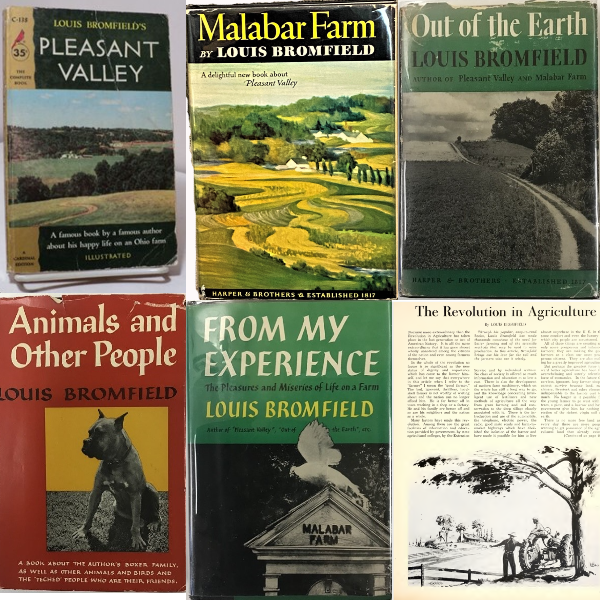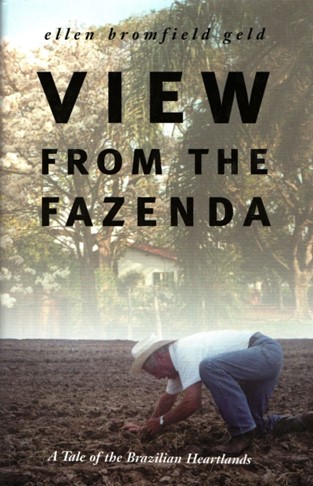In an article in the December 1954 issue of The Agricultural Education Magazine titled “Fiction for Future Famers,” Henry Brunner at Penn State listed 100 works of fiction that school librarians and experienced agriculture teachers recommended for FFA members. There are four books by Louis Bromfield in that list.
Who was Louis Bromfield and what were the books that were recommended? Our guest columnist for this Friday Footnote is Jim Connors from the University of Idaho. He will answer these questions.
Louis Bromfield & The New Agriculture
James Connors
Unless you hail from the State of Ohio, I would hazard a guess that most people in agricultural education have never heard of Louis Bromfield or the New Agriculture movement. However, anyone who is interested in modern-day sustainable agriculture should know about this agricultural prophet who helped to transform modern agriculture in the 1940s and 1950s.
Louis Bromfield was born in Mansfield, Ohio in 1896. He grew up loving to work on his grandfather’s farm outside of Mansfield. In 1914 he enrolled in Cornell University to study agriculture. After serving in World War I, he returned to the U.S. and enrolled in Columbia University to study journalism. He published his first novel in 1924. One of his early novels, titled The Farm (Bromfield, 1933), chronicled his experiences on his grandfathers’ farm in rural Ohio.
He quickly became a famous fiction writer with numerous novels published throughout the 1920s and 1930s. As a result of his successful writing career, he became friends with many Hollywood motion picture stars and eventually won a Pulitzer Prize in 1927.

Figure 1. Louis Bromfield
After living in Europe, he returned to Ohio in 1938 and purchased 600 acres of worn-out farmland in Richland County, Ohio. He named it Malabar Farm, after the Malabar coast of India that he loved. He quickly went about improving the soil quality on the farms by working with New Deal agencies such as the Soil Conservation Corps (now Natural Resources Conservation Service) and the Civilian Conservation Corps (CCC). Bromfield implemented new farming methods such as the use of green manure, cover crops, contour farming, and strip cropping to reduce erosion and improve the fertility of the soil.
In 1941 he became the first Vice President of a new organization called the Friends of the Land. This volunteer organization was made up of agriculturalists who wanted to improve the condition of agriculture and implement new farming methods to reduce soil erosion and improve soil health after the devastation of the Dust Bowl. The organization published a journal titled The Land to promote their cause widely among farmers in the United States.
Bromfield and Malabar Farm became so successful that people from all over the country flocked to central Ohio to tour the farm and hear him profess the wonders of the New Agriculture. As a result, Bromfield began writing about this movement in several non-fiction books. These books included:
- Pleasant Valley (1945)
- Malabar Farm (1948)
- Out of the Earth (1950)
- The Wealth of the Soil (1952)
- Up Ferguson Way (1953)
- Animals and Other People (1955)
- From My Experience: The Pleasures and Miseries of Life on a Farm (1955)

Figure 2. Some of the books written by Louis Bromfield. The bottom right image is from an article he wrote for the first issue of The National Future Farmer magazine.
Louis Bromfield was such a popular agriculture author that he wrote an article titled The Revolution in Agriculture that was published in the very first issue of The National Future Farmer magazine in Fall 1952. When writing on the definition of a “good farmer,” Bromfield wrote that:
…the good farmer is a man who knows as much as possible and never stops learning. He is a man who never thinks he knows all the answers and is perpetually willing to try anything new which seems to him practical and logical. He is a man who loves his land and animals and knows both as intimately as possible. He is also a man who thinks that for himself farming is the most wonderful profession on earth. (Bromfield, 1952, p. 40)
In the article’s conclusion, Bromfield wrote that, “The Future Farmers of America who are just starting out in life are doing so at what is probably the most exciting time in the whole history of agriculture” (p. 41).
Bromfield was a big supporter of agricultural education and youth programs. Writing in Pleasant Valley (Bromfield, 1945) he stated:
Today any farmer, any farm boy can have an excellent agricultural education without ever seeing a college campus. He can learn an incredible amount through the 4-H clubs, the Future Farmers of America, the S.C.S. [Soil Conservation Service], the county agent and other agencies and organizations. Nearly all the boys and young men who helped in the experiment of Malabar had taken advantage of some or all of these opportunities (p. 105).
Bromfield’s philosophy of the New Agriculture was widely accepted across the United States. Many agricultural professionals sought out Bromfield’s expertise and wanted to disseminate his agricultural theories and practices across the country and even around the world. In 1949 wealthy entrepreneurs in Oklahoma convinced Bromfield to establish Malabar Experimental Farm in Wichita County, Texas. The official name of the operation eventually became Louis Bromfield’s Wichita Falls Malabar Farm. The goals for the experimental farm were to improve the soil and agricultural productivity of the land and stimulate development in the area. Due to lack of support, limited water sources, and financial disagreements, the operation was never as successful as Malabar Farm in Ohio and eventually closed in 1954.
Malabar-do-Brasil
As stated above, the success of Malabar Farm in Mansfield, Ohio was so great that people from all over the U.S. traveled to visit Malabar and learn about the modern agriculture from Bromfield. Visitors interested in the new agricultural methods also arrived from many other countries around the world. In the summer of 1941 a wealthy entrepreneur from São Paulo, Brazil arrived to meet Louis Bromfield. Eventually Bromfield would travel to Brazil, a country he had never visited, to meet with other businessmen who had a desire to improve the agricultural production in the South American country.
The Brazilian business leaders eventually asked Bromfield to become a partner with them to establish Malabar-do-Brasil. A large, worn-out, coffee plantation in south central Brazil was purchased and would eventually be named Fazenda Malabar-do-Brasil. In writing about the land Bromfield stated:
The history of the countryside was not much different from that of our own cotton South. Poor agricultural methods and exploitation without intelligence had gradually ruined the land over generations and even centuries (Bromfield, 1955, p. 103).
Bromfield and his Brazilian partners introduced new agricultural practices to restore the land, established a diverse agricultural cropping and livestock system and restored the home and buildings on the fazenda. A section of the plantation was even set aside as an experimental demonstration farm. Bromfield wrote the following about the project:
The team…transformed the old, half-abandoned fazenda into a pilot farm which could bring benefits not only to those engaged in the enterprise but to the whole of Brazilian agriculture, welfare, and the national economy (Bromfield, 1955, p. 111).
I cannot emphasize too much the importance of establishing such an area both to the economy of the fazenda and to its prestige and its contributions in general to the agriculture and horticulture of South Central Brazil (Bromfield, 1955, p. 125).
Bromfield’s daughter, Ellen Bromfield Geld, and her husband, would eventually move to Malabar-do-Brasil and take over management of the operation. Both had graduated with degrees in agriculture from Cornell University. Ellen Bromfield Geld also wrote weekly columns on agriculture for Brazilian agriculture and women’s magazines. Geld, like her father, would eventually become an author and write a book about her agricultural experiences in Brazil titled View from the Frazenda: A Tale of the Brazilian Heartlands (Geld, 2003).

Figure 3. View From the Fazenda
Malabar Farm State Park
After Bromfield’s death in 1956, Malabar Farm was purchased by the Friends of the Land foundation of which Bromfield had been President. Eventually the land was deeded to the State of Ohio in 1972 and operated jointly by the Ohio Department of Agriculture and the Ohio Department of Natural Resources. In 1973 Malabar Farm was placed on the National Registry of Historic Places. Finally in 1976, Malabar Farm State Park was officially opened to the public.
Conclusions
Today, Bromfield’s legacy of love of the land continues at Malabar Farm. It is a working farm that preserves the land and legacy of Louis Bromfield’s agricultural philosophy for generations to come. Louis Bromfield was a man of the land who loved agriculture, the land, and the people who produced the food we eat. He used his experiences and knowledge to improve the land and restore it to productive condition. He espoused regenerative, sustainable agriculture before these practices were well known. Bromfield (1945) shared his love of agriculture when he wrote:
I know today that any good farmer has to be a little “teched” and when I go over the list of good farmers I know, there is not one of whom it could not be said, “He is a little ‘teched’,” for it means that he loves his land, his animals and his trees and understands them all. He farms not in order to make money but because of the pleasure and the satisfaction there is in it, because it is a destiny he would not change for any other in the world. Success and profit follow, but they are merely incidental (p. 95).
Agricultural students of today can still learn about Bromfield’s philosophy about the New Agriculture by reading his many books. I encourage you to find one of his books in your local library, a reprint on Amazon, or an original on Ebay. They make for wonderful reading about the importance of agriculture and preserving the agricultural heritage we all share.
Websites:
- Malabar Farm State Park – https://ohiodnr.gov/go-and-do/plan-a-visit/find-a-property/malabar-farm-state-park
- Malabar Farm Foundation – https://malabarfarm.org/malabar-farm/
References:
- Bongartz, R. (1974, May 19). Malabar farm: Louis Bromfield’s paradise lost. New York Times. https://www.nytimes.com/1974/05/19/archives/malabar-farm-louis-bromfields-paradise-lost-aim-of-the-experiment.html
- Bromfield, L. (1933). The farm. P.F. Collier & Son
- Bromfield, L. (1944). Animals and other people. Harper & Brothers.
- Bromfield, L. (1945). Pleasant valley. The Wooster Book Company.
- Bromfield, L. (1948). Malabar farm. The Wooster Book Company.
- Bromfield, L. (1948). Out of the earth. Harper & Brothers.
- Bromfield, L. (1952, Fall). The revolution in agriculture. The National Future Farmer Magazine, 1(1), 11, 40, & 41.
- Bromfield, L. (1955). From my experience: The pleasures and miseries of life on the farm. Harper & Brothers.
- Geld, E. B. (1962). The heritage. Ohio University Press.
- Geld, E. B. (2003). View from the fazenda: A tale of the Brazilian heartlands. Ohio University Press.
- McKee, T. B. (2020, March 28). Saving the trees at Malabar farm: 1957. Richland County History. https://richlandcountyhistory.com/2020/03/28/saving-the-trees-at-malabar-farm-1957/
